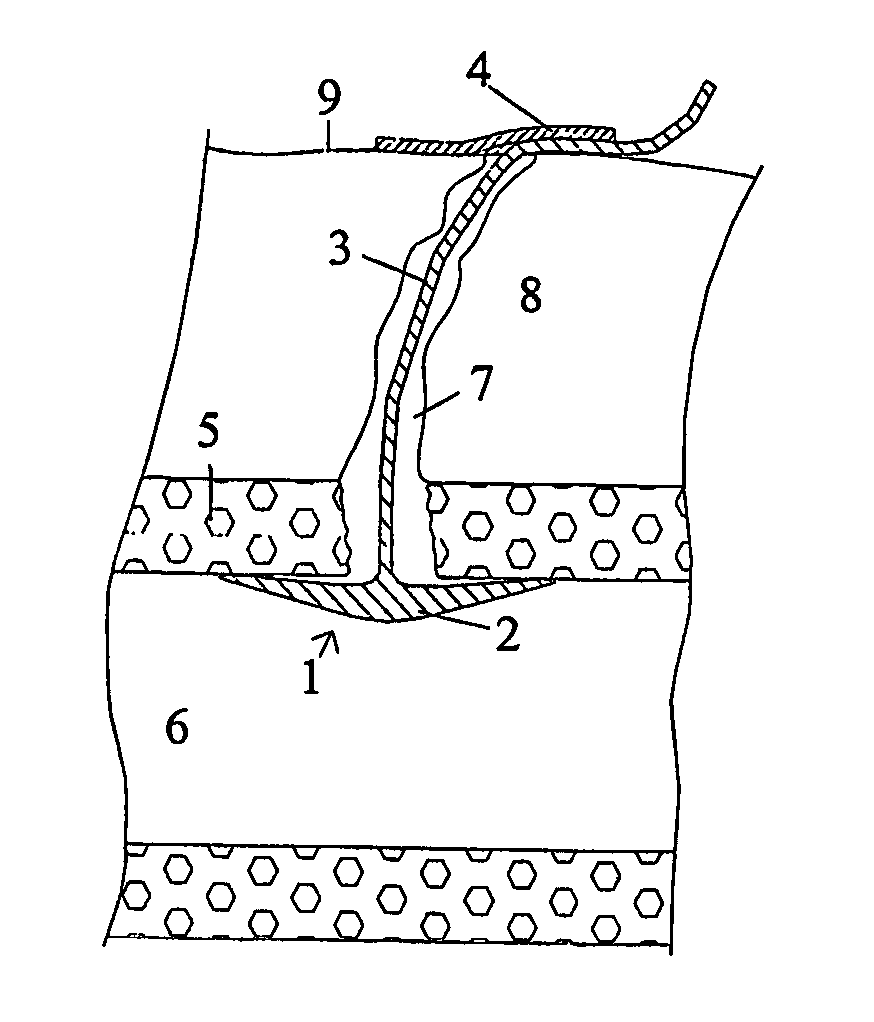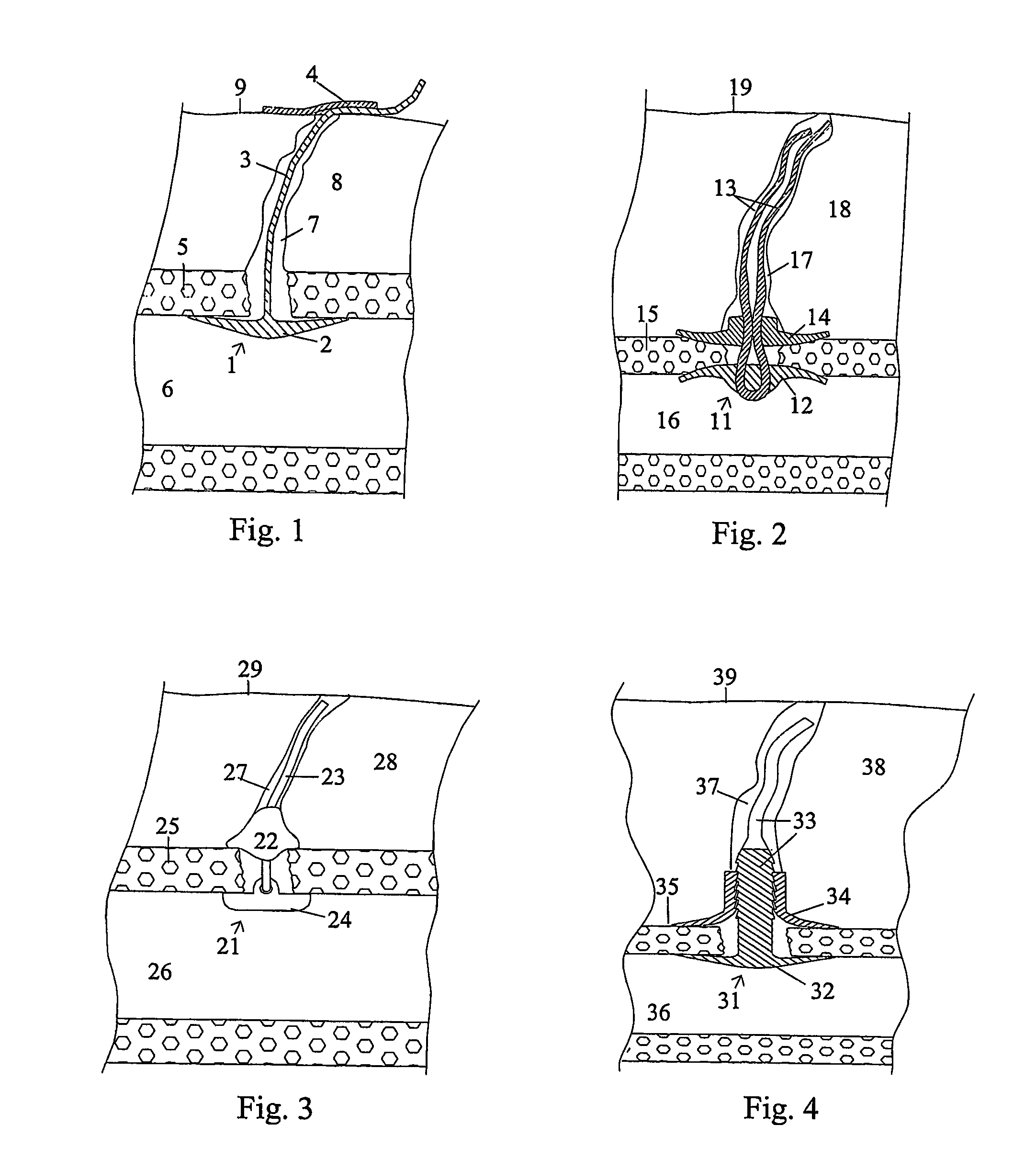Wound closure and sealing device
a sealing device and wound technology, applied in the field of wound closure and sealing devices, can solve the problems of not taking any measures to prevent or reduce bleeding,
- Summary
- Abstract
- Description
- Claims
- Application Information
AI Technical Summary
Benefits of technology
Problems solved by technology
Method used
Image
Examples
first embodiment
[0022]FIG. 1 illustrates a sealing device 1 according to the present invention. The sealing device 1 comprises a sealing element 2 and an elongated member 3, which is attached to the sealing element 2. In use, the sealing element 2 is positioned against an inner surface of a wall 5 of a vessel 6, while the elongated member 3 is positioned in an incision canal 7 extending from the vessel wall 5, through tissue 8 and to the skin 9 of a patient. In this embodiment, a piece of adhesive tape 4 has been attached to the skin 9 and to an end portion of the elongated member 3 in order to hold the elongated member 3 taut, thereby holding the sealing element 2 in sealing engagement with the inner surface of the vessel wall 5. According to the invention, the elongated member 3, which can be in the form of a suture or filament, comprises a haemostatic material that stops secondary bleeding in the incision canal 7. Examples of different suitable haemostatic materials as well as examples of how su...
third embodiment
[0024] a sealing device 21 according to the invention is illustrated in FIG. 3. The sealing device 21 comprises a sealing element 22, an elongated member 23, and an anchoring member 24 attached to the elongated member 23. In this embodiment, the sealing element 22 is in the form of plug 22 made from a suitable material such as collagen. In use, the plug 22 is pushed into position against an outer surface of a wall 25 of a vessel 26, with the elongated member 23 being positioned in an incision canal 27 extending from the vessel wall 25, through the sealing element 22 and through tissue 28, and to the skin 29 of a patient. As should be apparent from the figure, the sealing is in this case performed at the outside of the vessel 26, with the anchoring member 24 mainly acting as an anchor for the elongated member 23 to thereby hold the elongated member 23 and the sealing element 22 in place. Also here the elongated member 23, which can be in the form of a suture or a filament, comprises ...
fourth embodiment
[0025]FIG. 4 is a schematic illustration of the present invention. Here, a sealing device 31 comprises a first sealing element 32 and an elongated member 33, which extends from the first sealing element 32 and through a second sealing element 34. A portion of the elongated member 33 has been provided with saw-teeth that fit into corresponding saw-teeth in the second sealing element 34. In use, the first sealing element 32 is positioned against an inner surface of a wall 35 of a vessel 36. Thereafter, the second sealing element 34 is pushed over the elongated member 33 until the vessel wall 35 is clamped between the first and second sealing elements 32, 34, which are held in place by the saw-teeth provided on the elongated member 33 and the second sealing element 34, respectively. In this position, a proximal portion of the elongated member 33 extends in an incision canal 37 leading from the vessel wall 35, through tissue 38 and to the skin 39 of a patient. According to the invention...
PUM
 Login to View More
Login to View More Abstract
Description
Claims
Application Information
 Login to View More
Login to View More - R&D
- Intellectual Property
- Life Sciences
- Materials
- Tech Scout
- Unparalleled Data Quality
- Higher Quality Content
- 60% Fewer Hallucinations
Browse by: Latest US Patents, China's latest patents, Technical Efficacy Thesaurus, Application Domain, Technology Topic, Popular Technical Reports.
© 2025 PatSnap. All rights reserved.Legal|Privacy policy|Modern Slavery Act Transparency Statement|Sitemap|About US| Contact US: help@patsnap.com



